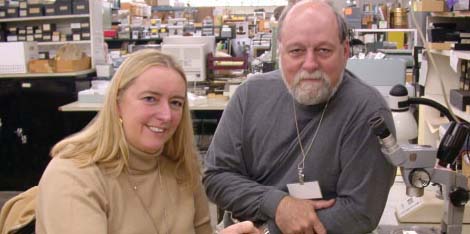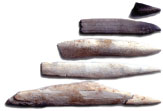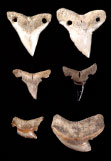A team of specialists from the Florida Museum of Natural History Environmental Archaeology Program has identified the Archaic people of Lake Monroe in central Florida as hunter-fisher-gatherers who made efficient use of their local environment, arranged their settlement according to specific activities and traveled to the coast to trade.
Archaeological Consultants Inc. of Sarasota contracted with museum scientists to study plant and animal remains and soil characteristics at the Lake Monroe Outlet Midden Site in 1999 before it became inaccessible because the Florida Department of Transportation widened the Interstate 4 bridge across the St. Johns River at this location.

Photo by Leslie Greene
The site is located on the northwestern shore of Lake Monroe in Volusia County, where the St. Johns River narrows back into its channel. The site rises from the swampy, cypress-rimmed lakeshore to a small sand ridge. Deep, layered middens (prehistoric garbage heaps) containing great quantities of freshwater shells cover part of the sand ridge, along with a late Archaic Period (5,000 to 3,000 years ago) stone tool workshop that was set apart from a general living areas.
People first lived at this site around 4,700 years ago, before the invention of pottery in southeastern North America. The refuse they left behind presents an opportunity to examine Archaic Period life ways and the environment of east-central Florida, at a time of considerable environmental and cultural change.
The museum’s study of bone and shell presents a picture of a people who primarily hunted and gathered aquatic resources from the shallow edge of the lake and river. This conclusion is based on the recovery of abundant remains of small catfishes, sunfishes and freshwater eels that are common in shallow vegetated areas.
Apple snails and mussels from the grassy shallow water zones were the most frequently identified animals in the site. To a lesser extent, terrestrial animals such as fox squirrels, white-tailed deer, box turtles and gopher tortoises were hunted in the hammocks and open areas bordering the lake and river, thus adding variety to the diet. Bones of white-tailed deer also provided a source of durable material for tools and ornaments.

Photo by Leslie Greene
The presence of marine resources provides clear evidence for regular travel and trade to the coast. Although some of the animals could have been used as food, many were not. For example, notched and drilled shark teeth were used as tools. Most of the marine shells also were altered to produce tools, ornaments, or utensils such as cups. Most of the shell vessels were charred, apparently in the cooking process.
Early plant husbandry, such as cultivating squash and bottle gourd, was under way in other parts of Florida at the time that the Lake Monroe Outlet site was occupied, but there is no evidence for such activity from this site. Plant remains identified at the site include hickory, oak, saw palmetto, hackberry, greenbrier, cabbage palm and other species from broad-leaf and pine forests. Nuts were important in the diet along with fruits and some greens. Hickory nuts and acorns provide protein and oils while their shells and hulls likely were used as kindling along with charred pine and oak fuel found in a hearth-like feature. Blueberry, hackberry, cabbage palm, saw palmetto, and greenbrier have edible fruits and other plant parts. Greenbrier also has edible shoots and a tuber that produces flour called “red coontie.”

Photo by Leslie Greene
Studying soils helps to interpret what people did in different parts of the site. An example is found in the colorful and oddly shaped soil horizons beneath the stone tool (lithic) workshop. These soils are naturally occurring and not unusual, although their gaudy, contorted contours were unexpected. The most interesting thing about them is what is not there.
Most archaeological soils are enriched in calcium (from shell and bone of food animals) and phosphorus (from the bone and discarded soft tissue of animals). The larger the human population at the site, or the longer they inhabited it, the higher the content of these soil elements. The differences between chemical signatures of the general midden areas (and even the off-site units) compared with the workshop are extraordinary: there is a kind of “clean room” effect at the workshop, as if no one were allowed to drop a single shell or bit of refuse there. The workshop not only was located apart from general living areas, but the specialized production of stone tools was not intermixed with other regular activities such as food preparation or storage.
Scientists are not sure why this activity was so guarded from day-to-day activities. One idea is that it was due to the regional scarcity of lithic resources in Florida. More research also is needed to see if this pattern occurs at other sites in Florida and the Southeast United States.